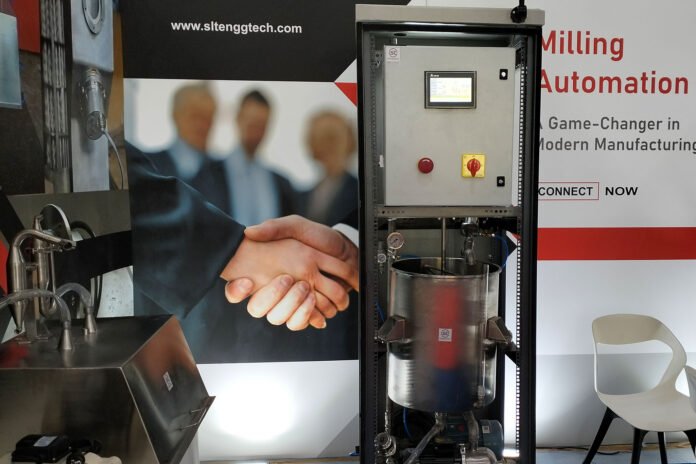The crux of successful poultry production lies in the quality of the feed provided to the birds. A balanced diet is paramount for their growth, health, and the profitability of poultry farming operations. Manufacturing poultry feed is a meticulous process that begins with selecting suitable ingredients rich in proteins, vitamins, and minerals. These ingredients are ground, mixed, and often pelleted to facilitate easy consumption and digestibility. The process’s precision ensures the poultry’s survival and optimal performance, which in turn drives the sector’s overall efficiency and economic viability. By leveraging advanced feed manufacturing machinery, producers can maintain strict control over the nutrition and quality of feed, resulting in healthier poultry and high-quality produce for consumers.
Key Feed Processing Machines:
Detailed examination of each machine’s role in the manufacturing line, from grinding to packaging.
Feed Grinder: At the onset of the production line, the Feed Grinder is crucial. Grinding ingredients to a suitable particle size aids digestibility and ensures that subsequent mixing is more efficient. This machine is tailored to maintain the integrity of the nutrients during the grinding process.
Feed Mixer: The homogeneity of feed is essential—unequal distribution of nutrients can lead to selective eating and nutrient imbalances. The Feed Mixer evenly blends powdered ingredients with added liquids, critical for producing a balanced feed.
Feed Pellet Mill: This machine is at the heart of the pelletizing process. The Feed Pellet Mill transforms the blended feed mixture into dense, uniform pellets through extrusion and pressing. This enhances feed management and reduces waste.
Feed Pellet Cooler: The pellets are hot and contain moisture after pelletizing. The Feed Pellet Cooler reduces their temperature and moisture content, ensuring the pellets are stable and have a prolonged shelf life.
Feed Pellet Crumbler: Pellets are not one-size-fits-all. The Feed Pellet Crumbler is designed to break down larger pellets into smaller pieces, which is especially beneficial for young birds struggling with standard-sized pellets.
Feed Pellet Screener: Quality control is vital. The Feed Pellet Screener eliminates undesirable fines and non-uniform pellets, producing a consistent final product that meets predefined standards.
Feed Pellet Packing Machine: A final step before the feed reaches the consumer is packaging. The Feed Pellet Packing Machine ensures the pellets are bagged appropriately, preserving the quality of the feed during storage and distribution.
Feed Hammer Mill: The Feed Hammer Mill is often utilized for more robust materials. Like the Feed Grinder, its purpose is to reduce particle size, but it is specifically engineered to handle harder raw materials more efficiently.
Feed Conveyor: This equipment is the transport link within the production line. The Feed Conveyor systematically moves materials from one process to the next, contributing to a smooth and continuous operation.
Post Pellet Liquid Applicator: The application of liquids to pellets enhances their nutritional value and attractiveness. The Post Pellet Liquid Applicator accurately sprays liquids onto pellets, augmenting their overall quality.
Advancements in Feed Production Technology:
Advancements in feed production technology have revolutionized the poultry industry by enhancing the quality, uniformity, and digestibility of feed. Cutting-edge techniques like Near-Infrared Spectroscopy (NIR) allow for real-time analysis of ingredient composition, ensuring that each batch of feed meets precise nutritional specifications. Robotic and automated systems have streamlined the production process, reducing manual errors and increasing output. Furthermore, data analytics and machine learning are employed to optimize feed formulas based on factors such as climate, season, and the specific needs of poultry breeds, paving the way for precision feeding strategies that promote growth and reduce waste. These technological innovations not only bolster the efficiency of feed manufacturing but also contribute to more sustainable poultry farming practices.
Operational Considerations for Feed Mills:
Operational efficiency in feed mills is contingent upon a well-planned setup that meticulously orchestrates various machines and processes. Effective scalability allows for expanding production volume without compromising product quality or operational fluency. To ensure seamless operations, feed mills need to invest in modular systems that can be easily upgraded or reconfigured according to the market’s changing demands.
Machinery maintenance is another pivotal aspect affecting the longevity and reliability of a feed mill’s operations. A rigorous preventative maintenance schedule is essential to circumvent potential breakdowns that can lead to costly downtimes. Regular inspections, lubrication, and replacement of worn-out parts are crucial tasks that prevent unexpected machinery failures. Training for maintenance staff is equally important, as their expertise directly impacts the efficiency and safety of the equipment.
Impact of Machinery on Feed Quality and Poultry Health:
The precision and quality of machinery used in producing poultry feed directly impact the final product’s quality. Precisely engineered equipment ensures that the feed’s particle size remains consistent, crucial for optimal digestion and nutrient absorption in poultry. Uniform feed particles reduce the risk of feed selection by the birds, leading to a more balanced nutrient intake. This, in turn, plays a pivotal role in poultry’s overall health and growth rates.
Moreover, advancements such as the Post Pellet Liquid Applicator ensure that each pellet is evenly coated with nutritional additives, which can enhance immunity and improve feed palatability, thus influencing feed conversion ratios and meat or egg production positively. Consistent feed quality, aided by sophisticated machinery, minimizes the risk of disease in poultry populations by promoting a stronger and more resilient immune response.
Consequently, this drives a decrease in the need for antibiotics, aligning with consumer demand for more natural and sustainable poultry products. The interplay between machine precision and feed quality is a cornerstone for maintaining healthy poultry and securing high productivity within the poultry industry.




